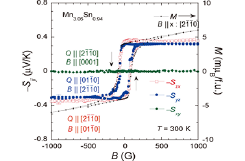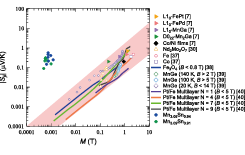Large Anomalous Nernst Effect at Room Temperature in a Chiral Antiferromagnet
Nakatsuji Group
The anomalous Nernst effect (ANE) is the thermoelectric counterpart to the anomalous Hall effect (AHE), that is, when one applies thermal gradient to a ferromagnetic conductor, spontaneous voltage drop will appear perpendicular to both the applied heat current and the direction of the magnetization. In earlier studies, these two phenomena have been considered to be proportional to the magnetization. However, modern theory of transport properties based on Berry phase has opened up the possibilities of observing anomalous transport effects in materials with zero net magnetization, such as in antiferromagnets (AFM) [1].

Fig. 1. Anisotropic magnetic field dependence of the Nernst signal Sji (i, j = x: [2110], y: [0110], z: [0001]) in Mn3Sn.

Fig. 2. Magnetization dependence of the spontaneous Nernst signal |Sji| for various ferromagnets and Mn3Sn. References for each listed materials can be found in [4].
Mn3Sn is a metallic AFM crystallizing in the hexagonal structure, with Mn atoms forming a kagome lattice in the ab plane that is stacked along the c-axis. Below the Neel temperature of 430 K, Mn spins undergo a transition from a paramagnetic state to a non-collinear, inverse triangular spin structure [2]. The orthorhombic symmetry of this magnetic orders permits an exceedingly tiny in-plane spontaneous magnetization ~ 2mμB/Mn to appear, the direction of which can be controlled by a small magnetic field of ~ 200 Oe. Experimentally, Mn3Sn exhibits large anomalous Hall conductivity in this non-collinear phase, the first case for AFM [3]. In this study, we measured magneto-thermoelectric transport of two off-stoichiometric Mn3Sn single crystals with slightly different compositions, Mn3+xSn1-x (x = 0.06 and x = 0.09). We found that for Mn3.06Sn0.94, the anomalous Nernst coefficient Szx is 0.35 μV/K at room temperature (Fig. 1) and reaches 0.6 μV/K at 200 K [4], comparable to the maximum value measured for ferromagnetic metal [5]. This Nernst coefficient is around 100 times larger than what we would naively expect based on the size of its magnetization (Fig. 2).
The anomalous Nernst coefficient Szx is governed by the transverse thermoelectric conductivity αzx, which is related to the Hall conductivity σzx through the Mott relation. From this relation, we can infer that ANE can be enhanced when the Berry curvature takes a large value in the vicinity of EF. First-principles calculations suggest the existence of Weyl nodes around E ≈ EF + 60 meV at which the Hall conductivity peaks. Moreover, the Mn off-stoichiometry is predicted to provide electron carriers that shift EF towards the location of the Weyl nodes, which may account for the difference in the magnitude and temperature dependence of the σzx and αzx between the two measured single crystals.
From a practical standpoint, the anomalous Nernst effect may become useful as the orthogonal orientation between the voltage output and the input heat current allows the construction of thermoelectric module much simpler than the usual pillar-like design utilizing the Seebeck effect. In spite of the small magnitude of the ANE observed in this material, our study may provide a guide for the search of materials more suitable for future thermoelectric power generation.
References
- [1] M.-T. Suzuki, T. Koretsune, M. Ochi, and R. Arita, Phys. Rev. B. 95 (2017).
- [2] T. Nagamiya, and Y. Yamaguchi, Solid State Commu. 42 (1982).
- [3] S. Nakatsuji, N. Kiyohara, and T. Higo, Nature 527 (2015).
- [4] M. Ikhlas, T. Tomita, T. Koretsune, M.-T. Suzuki, D. Nishio-Hamane, R. Arita, Y. Otani, and S. Nakatsuji, Nat. Phys. 13 (2017).
- [5] K. Hasegawa, M. Mizuguchi, Y. Sakuraba, T. Kamada, T. Kojima, T. Kubota, S. Mizukami, T. Miyazaki, and K. Takanashi, Appl. Phys. Lett. 106 (2015).
